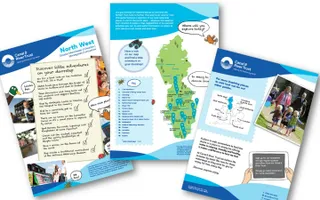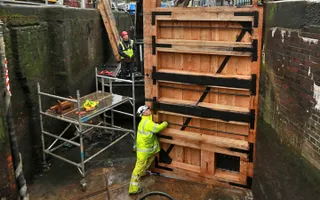The Rochdale Canal crosses the rugged heights of the Pennines from Manchester to Sowerby Bridge. The steep climb means lots of locks and an exhausting but exhilarating journey with stunning views.
For boaters, this canal is a peaceful place to escape the crowds along the Two Roses Ring. The towpath is probably the easiest walking route through the Pennines, taking you into the heart of the hills at a relatively gentle gradient. However, there is also plenty of access to more challenging routes for serious hiking.
The Rochdale Canal re-opened to boats in 2002 after an ambitious volunteer restoration project that brought an end to more than 50 years without through navigation. Obstacles had included two motorways, countless road blockages and a scheme to fill the channel with concrete.
Days out along the Rochdale Canal
Download our free family days out guides - Hebden Bridge is just one of 123 places to visit along our canals.
The Rochdale Canal history
In 1804, the Rochdale became the first of our three trans-Pennine canals to be fully opened - perhaps due to the choice of a route over the top of the Pennines, avoiding the problems with tunnel construction that had bedevilled the other two waterways.
Principal cargoes included coal, agricultural produce and materials for the textiles industry. The large number of locks on a relatively short length of canal, rising to a height of over 600 feet (180m), meant that water supply was always a problem. Seven reservoirs were built especially to service the line.
Locks were made large enough to accommodate broad-gauge (14ft), boats with commercial payloads of up to 70 tons. All the locks were made with exactly the same fall: this meant all the gates were the same size, making maintenance easier, and conserved water by using the same amount of water for each lock operation.
The canal proved a success until the combined effects of road and the decline in traditional industries took their inevitable toll. The last regular through-traffic ended just before World War II, and by the 1950s commercial carrying had virtually ceased altogether. Unusually, the canal had not been nationalised in 1948, and remained in private ownership.
The canal closed as a through route just four years later. One short length remained: the nine locks in central Manchester between the Ashton Canal and the Bridgewater Canal, which was an essential part of the Cheshire Cruising Ring.
Restoration work on the Rochdale Canal began in the 1970s, and the following decade saw much of the canal reopened on the Yorkshire side from Littleborough eastwards. This was reconnected to the waterway network in 1996 by the glorious new lock at Tuel Lane near Sowerby Bridge, which combines two earlier locks so that the canal may tunnel under a road built on its original level. At almost 20 feet (6m) deep, it vies with Bath Deep Lock for the title of the deepest lock in Britain.
Restoration of the Rochdale Canal entailed the total refurbishment of 24 locks, the cutting of a new section of channel, massive dredging of the original line and the construction of 12 new road bridges. It was reopened throughout in 2002 and now, together with the reopened Huddersfield Narrow Canal, forms part of the South Pennine Cruising Ring.









